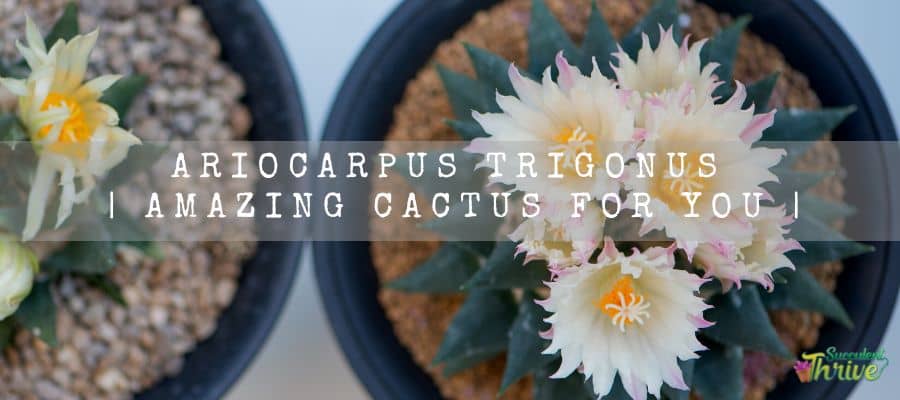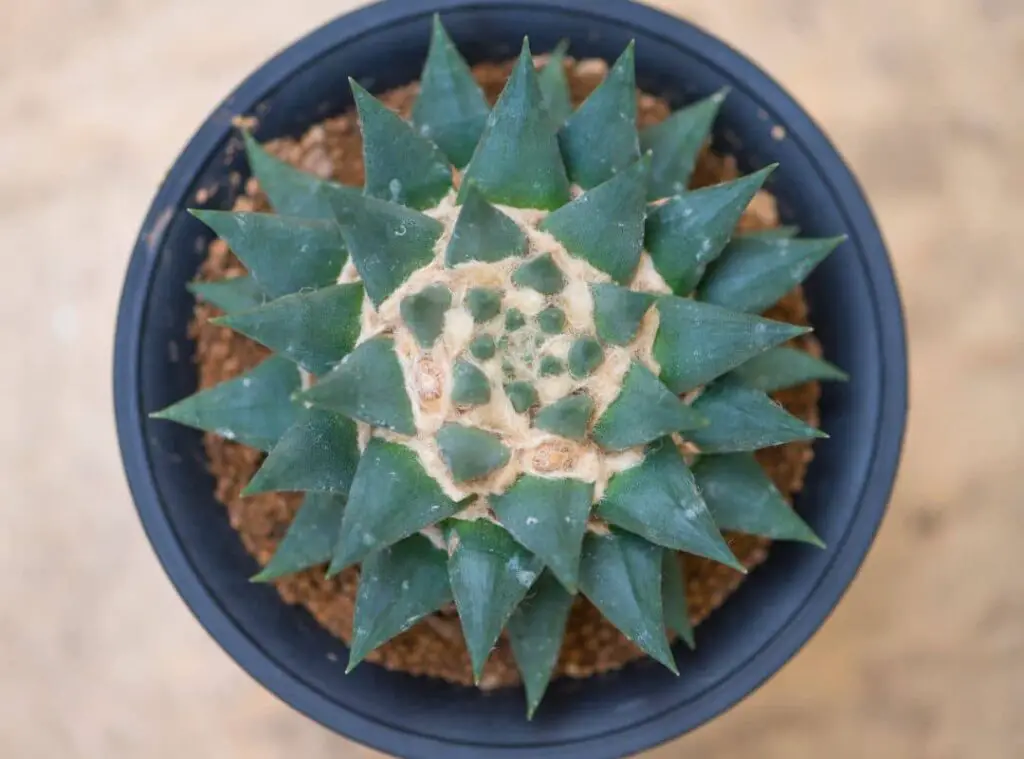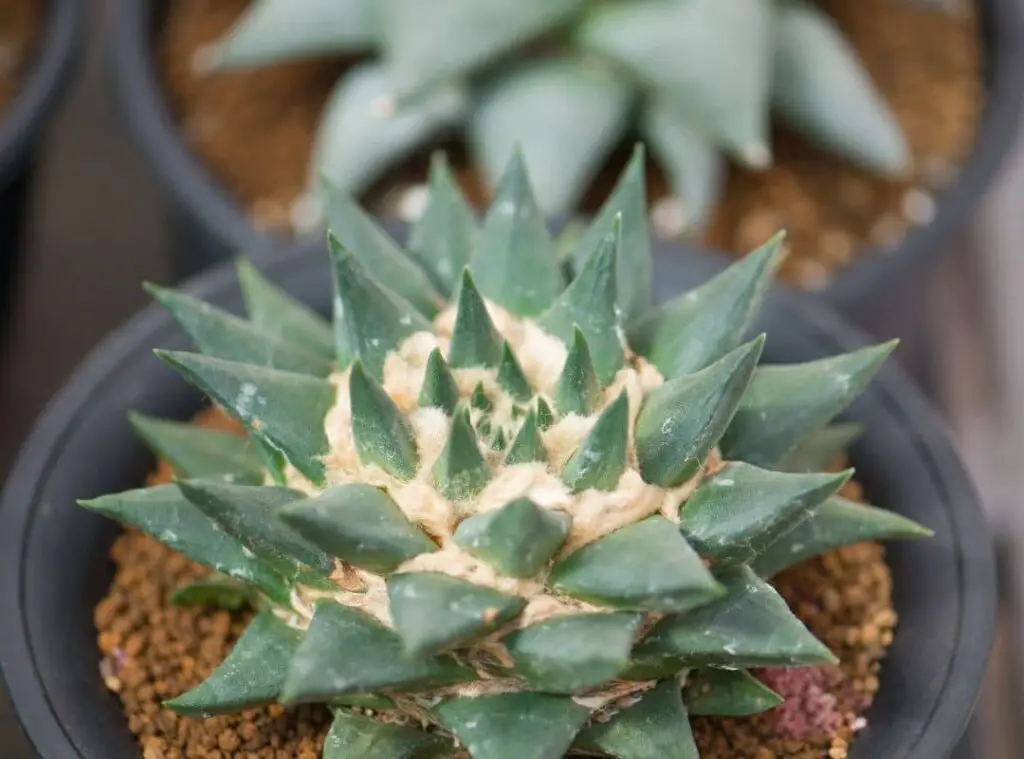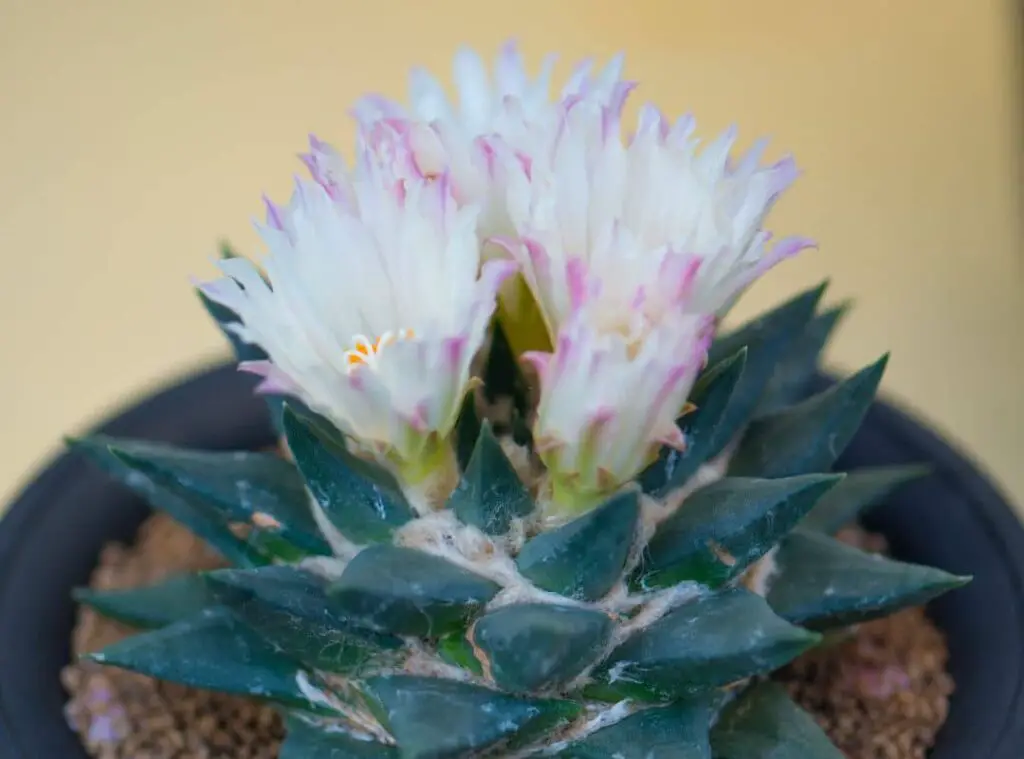Ariocarpus trigonus are native to Mexico and are extremely unique plants. They would usually grow in areas which are 600-1200 m above sea level.

Furthermore, they would usually form in colonies as well. Ariocarpus trigonus plants are quite popular for their unique foliage among the succulent cactus enthusiasts. These are yet another rare set of plants which anybody would fall in love with.
Ariocarpus trigonus comprises branch whorls which consist of small thick leaves and tiny spines as well.
They are glamorous plants which would resemble an effect of Easter cactus or Homalocephala blushing bride.
So, I hope now you are all set to learn on these beauties , on how to provide the right growing conditions, how to overcome the bugs and diseases they may experience and on their propagation methods as well
How do I identify Ariocarpus trigonus?
Ariocarpus trigonus are small cacti types. They are a globose shaped plant which comes off from the ground merely.
They would be about 4- 25 cm in height at maturity. Furthermore, they would be about 5-30 cm in width too.
Irrespective of the fact that they belong to the Cactaceae family, they don’t tend to look like cacti at all. To elaborate on this, Ariocarpus trigonus leaves look completely in contrast with the rest of other cactus leaves.
They usually come up as spineless plants. The leaves would form in an erect shape . Further they tend to take a triangular pointed shape too.
The leaves are quite sharp as well. Those leaves would be 4-8 cm long 1-3 cm broad. Biologically speaking, they would be, the leaves are more like tubercles of the plants.
You could spot Ariocarpus trigonus carrying areoles only in the basal part of the plants. Furthermore, you could see a wooly white fluffy button shaped growth developed among the leaves as explained in the above.
They are quite useful for the water conservation purpose of the plants. In other words, they would reduce the water loss from the transpiration which takes place in the stem.
Ariocarpus trigonus roots would tend to look like taproot. On another note, this is very much crucial in making them survive in hot and arid weather conditions when they grow in the wild.
Furthermore, they would be helpful to conserve nutrients also. Ariocarpus trigonus usually develops one individual rosette.
Botanically speaking the rosette is more like a circular arrangement which is made out of leaves.
Ariocarpus trigonus produces flowers which are breathtaking. Well, this is one of the main factors which attract the succulent growers.
Those flower blossoms are pink or cream or yellow colored. Further they would consist of several petals as well.
Ariocarpus trigonus blooms would be 5 cm wide and 4 cm tall. Those flowers would usually form right on top of the stems.
Further they would form in clusters of three flowers at one flowering time. Those blossoms are showy which would attract anybody’s attention.
Flower blossoming would take place in late autumn or in early winter. Once the flowers fade away, they would become globose shaped fruits, you could spot them in green.

Growth rate
Ariocarpus trigonus are a slow growing set of plants.
One look care guide
| Botanical Name | Ariocarpus trigonus |
| Plant Type | Cactus |
| Mature Size | About 4- 25 cm in height / 5-30 cm in width |
| Sun Exposure | Full sunlight to partial shade |
| Soil Type | Well draining |
| Soil pH | 6 and 7 |
| Bloom Time | Late autumn or early winter |
| Flower Color | Pink or cream or yellow colored |
| Hardiness Zones | USDA zones 10a -1.1 °C (30 °F) to +1.7 °C (35 °F) |
| Native Area | Mexico |
| Toxicity | Toxic |
| Average price | $ 48 |
How do you take care of Ariocarpus trigonus?
Light Requirement
In terms of the right light levels, Ariocarpus trigonus would prefer to have full sunlight and partial shade parallel.
In other words, they would prefer to have full sunlight during early morning hours and partial shade during the hottest part of the day.
The exposure to extensive sunlight may cause sunburns for them. Hence, do not leave them uncovered for full sunlight during the intensely hot warmer hours of the day.
Besides, if you have cultivated them indoors for too long and want to bring them outdoors I suggest you slowly expose the plants for full sunlight.
The abrupt exposure for sunlight would be hateful for the plants. When you grow them indoors you need to go ahead with a bright sunny windowsill.
Moreover, if you still find it difficult to fulfill the sunlight requirement of the plants, you may supplement the lighting by placing grow lights closer to the plants.
Temperature and humidity
Ariocarpus trigonus would want warmer temperatures to grow to their best potential. Further it would be quite crucial to produce flower blossoms as well.
Ariocarpus trigonus plants are somewhat frost hardy up to -10 degrees Celsius given that you are keeping the plants dry.
However never expose them for much colder conditions for too long as it would not be healthy on the plants.
Consider that you have grown them outdoors and expect a severe frost condition, so I recommend the best thing you could do is to bring them indoors.
The optimal temperature which would perfectly fit in for these plants would be 5 degrees Celsius ( 41 degrees Fahrenheit ) in winter.
On the other hand, a temperature range between 15-20 degrees Celsius ( 59-68 degrees Fahrenheit ) would be ideal for them during the rest of the year. They are tolerant of higher temperatures such as 40 degrees Celsius ( 104 degrees Fahrenheit 0
Is it cold hardy?
Ariocarpus trigonus are cold hardy up to -10 degrees Celsius.
Growth Zone
The conditions in USDA zones 10a -1.1 °C (30 °F) to +1.7 °C (35 °F) would be more appropriate for these plants.

Watering Requirement
Ariocarpus trigonus plants can thrive well with moderate watering so that it would avoid leaf loss.
Keep in mind that you need to water the plants more regularly but at moderate levels during summer. On the other hand, you need to cut back on watering in winter.
Soil Requirement Type / pH.
Ariocarpus trigonus usually grows in less fertile soil mixes which always tend to be dry. So, in cultivation also, you need to mimic the same conditions by providing a porous soil mix which is fast draining.
The right pH Level of the soil mix should be between 6 and 7. That said that they can also survive in soil mix which have a pH range of 4-8 also.
The most crucial factors to check on the chosen soil mix is whether they have excellent drainage and a good aeration.
Pot size Potting and Repotting
A terracotta or a clay pot would be ideal for these plants. Those are all porous materials which would ensure that the excess water would evaporate faster in the pots without retaining within.
Additionally, your selected pot needs to have one or two draining holes also. When it comes to repotting the plants, I suggest you do it every other year so that it would provide new growing conditions for the plants.
Where to Plant
You need to select a place where the plants can gain sufficient sunlight levels. It is the most crucial factor when selecting the right place to plant them.
Fertilizer and time of year
Ariocarpus trigonus have very minimal requirements when it comes to fertilizing. Having said that, lighting feeding would be ideal for them, especially when they are actively growing.
A liquid fertilizer or a weak solution fertilizer would be quite beneficial to do this task. Refrain from using solid fertilizers as they would result in root damage of the plants.
Flower
Ariocarpus trigonus emerge with flowers in cream white, yellow white. you could spot them flowering in late autumn to early winter.

Dormancy
They are winter dormant plants.
Toxicity
Ariocarpus plants are generally toxic.
Common bugs and illnesses.
Ariocarpus trigonus can combat pests’ attacks and other diseases successfully as they are strong contenders with them.
Apart from that, Ariocarpus trigonus may occasionally go through aphids’ attacks. They have a greater tendency to go through specially when they are small.
In addition to Aphids, spider mites may also be troublesome for these previous pants. To overcome them, you may simply use an insecticidal soap into soil once every week.
Besides these, they may also experience root rot conditions if you supply them water in excess.
Special Care tips
Ariocarpus trigonus don’t need major maintenance from you and you do not even have to prune the plants.
However, if you grow them for some time and if they have developed dead plant parts, you need to snip them off and secure the plants.
Unless you had kept them in the plants for too long, it would harm the plants. I suggest you cut a third of the oldest stem to the ground so that it would stimulate the development of the new shoots.
Ultimately it would make the rosette dense and more spectacular also
How to propagate Ariocarpus trigonus
You could use the stem cutting propagation method for the propagation method. Keep in mind that the cuttings should be 25 cm ( 10 inches ) in length and should contain one or two leaves at the edges of the cuttings.
Once you need to obtain the cuttings and allow them to wither. This will allow them to become callous. Next you can grow them in a fresh well draining soil mix.
Besides the stem cutting propagation method, you may use the seeds propagation method as well. The optimal temperature which would work well with germination of the seedlings would be around 20°C (68°F).
Ariocarpus trigonus benefits
Ariocarpus trigonus would be great picks for indoor gardening. They would add so much glamor , grace to your entire location.
Conclusion
To recap on what we covered here, Ariocarpus trigonus would be such fantastic plants to add on to your indoor gardens as well as for the outdoor gardens.
Above all , Ariocarpus trigonus are such a soothing set of plants which would make you feel calm and relaxed too.
So, I hope this information made you excited to have one of the Ariocarpus trigonus and that you are all set to grow the Ariocarpus trigonus plants !
Read Next : Peperomia Ferreyrae Dying | 7 Reasons |
